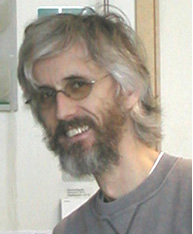
Matthias Mayer
Group Leader in the
DKFZ-ZMBH Alliance
ZMBH, Im Neuenheimer Feld 282
69120 Heidelberg, Germany
Tel.: + 49-6221 54 6829
Fax.: +49-6221 54 5894
m.mayer@zmbh.uni-heidelberg.de
![]() Download Calling Card
Download Calling Card
![]() Matthias Mayer's Annual Report
Matthias Mayer's Annual Report
Welcome to the Bukau Lab!
Protein folding in the cell: Mechanisms of chaperones and proteases
The ensemble of molecular chaperones constitutes the cellular system that assists folding and assembly of newly synthesized proteins, translocation of unfolded proteins across membranes, as well as refolding and degradation of misfolded and aggregated proteins. Chaperones furthermore control signal transduction pathways through association with kinases and transcription factors, thereby leading to their regulated inactivation or degradation. All these features render chaperones essential for growth and stress survival of cells and implicat them in evolutionary processes.
The long term goal of our research is to understand the intricate functional network of chaperones and proteases in the cytosol. As model systems we are using bacteria, yeast and mammalian cells, and we combine genetics and cell biology with biochemistry and biophysics as experimental approaches. Three project groups currently focus on the following aspects:
1. Mechanisms of chaperone-assisted folding of newly synthesized proteins: We are interested in elucidating how ribosome-associated chaperones such as Trigger Factor interact with and assist the co-translational folding of nascent polypeptides, and how the newly synthesized proteins are handed over to other chaperones acting downstream.
2. Functional network of Hsp70 machines: Hsp70 proteins with their co-chaperones are highly abundant and versatile ATP-driven chaperone machines involved in a large variety of protein folding processes. We are investigating the molecular mechanism of their activity, and the still enigmatic roles of members of the Hsp110 subfamily of Hsp70 chaperones.
3. Role of AAA-chaperones in protein disaggregation and degradation: AAA-chaperones form ring-shaped oligomers that use the energy of ATP to bind, unfold and translocate polypeptides through their central pore. This activity is employed by ClpB (Hsp104) for solubilization and refolding of aggregated proteins, and by ClpA for targeting substrates for degradation by an associated peptidase. We like to understand how protein disaggregation and degradation is achieved by these chaperones.
Selected Publications
Original Papers
Erbse, A., Schmidt, R., Bornemann, T., Schneider-Mergener, J., Mogk A., Zahn, R., Dougan, D.A., Bukau, B. ClpS is an essential component of the N-end rule pathway in Escherichia coli. Nature (2006) 439, 753-756 (see Abstract).
Vogel, M., Bukau, B., Mayer, M.P. Allosteric regulation of Hsp70 chaperones by a proline switch. Mol. Cell (2006) 21, 359-367. (see Abstract).
Weibezahn et al. Thermortolerance requires refolding of aggregated proteins by substrate translocation through the central pore of ClpB. Cell, (2004) 119(5):653-665. (see Abstract)
Schlieker et al. Substrate recognition by the AAA+ chaperone ClpB. Nat. Struct. Mol. Biol. 2004, 11, 607-615. (see Abstract)
Ferbitz et al. Structure of the trigger factor chaperone in complex with the ribosome defines the molecular environment of the emerging nascent protein chain. Nature 2004, 431, 590-596. (see Abstract)
Kramer et al. L23 protein functions as a chaperone docking site on the ribosome. Nature 2002 (see Abstract)
Mayer et al. Multistep mechanism of substrate binding determines chaperone activity of Hsp70. Nat Struct. Biol. 2000 (see Abstract)
Deuerling et al. Trigger factor and DnaK cooperate in folding of newly synthesized proteins. Nature 1999 (see Abstract)
Reviews
Bukau et al. Getting newly synthesized proteins into shape. Cell 2000 (see Abstract)
Bukau & Horwich. The Hsp70 and Hsp60 chaperone machines. Cell 1998. (see Abstract)


